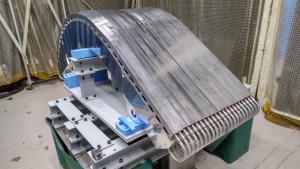Japan qualifies outer vertical target
A four-year program to manufacture and test a full-scale prototype of the divertor outer vertical target has successfully come to an end in Japan, as manufacturer Mitsubishi Heavy Industries receives the green light for series fabrication.
Jointly developed by Japan's National Institutes for Quantum Science and Technology (QST) and Mitsubishi Heavy Industries, the full-scale mockup of the outer vertical target has passed all performance and manufacturability tests and demonstrated the technology that will now be used by Mitsubishi to produce the 18* units that QST has ordered.
The ITER divertor is the component at the bottom of the vacuum vessel that, in extracting heat and ash produced by the fusion reaction, withstands the highest surface heat loads of the machine. Its role is critical—without the constant "hoovering" of impurities and exhaust, the plasma could not be maintained.
Specially armoured with tungsten tiles and actively cooled by water circulating in their structures, the divertor "targets" (the dome, outer vertical target and inner vertical target) receive the brunt of the heat load and particle flux from the plasma and withstand the highest surface loads of the ITER machine—estimated to reach 20 MW/m², or ten times the heat load of a spacecraft re-entering Earth's atmosphere.
In a press release published this summer, Mitsubishi stressed the challenge of working with tungsten—a high-temperature material, with a melting point that is the highest of any metal, but that is difficult to machine because it is brittle and prone to cracking. The company also stressed the high-precision fabrication and processing technologies that are required to produce the outer vertical target structures and the stringent alignment requirements for the plasma-facing units. Each tungsten tile (or "monoblock"). for instance. must be aligned with an accuracy of 0.5 mm or less in terms of inclination, surface level and clearance. "QST, backed by its innovative R&D capabilities, has been focusing on tokamak divertor development since before ITER, and MHI has leveraged its outstanding manufacturing capabilities to successfully produce a prototype of the outer vertical target."
Like for the other divertor targets—the dome produced in Russia and the inner vertical target produced in Europe—the performance of a Mitsubishi test assembly of tungsten plasma-facing units for the outer vertical target was assessed at the divertor high heat flux test facility in Russia, where it successfully passed 6,000 test cycles with loads from 5 to 20 MW/m². The ITER Organization has now certified the prototype's heat removal performance as well as the manufacturing process for the highly technical plasma-facing units. Series production can begin.
*Of the 58 outer vertical target units that QST will deliver to ITER, Mitsubishi Heavy Industries is responsible for manufacturing 18.
See the Mitsubishi Heavy Industries press release in English and Japanese.



